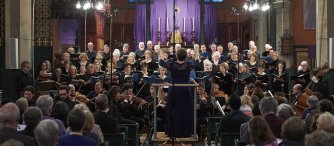Details
St Michael and All Angels Church
Bath Road
Chiswick
London
W4 1TT
England
Programme
Joseph Haydn – Mass no.11 in D minor 'Nelson', Hob.XXII:11
Gabriel Fauré – Requiem, Op.48 (1883)
Performers
Lucy de Butts – soprano
Emma Watkinson – mezzo-soprano
Gareth Treseder – Tenor
Geoff Williams – Bass
Ben Lewis-Smith – organ
Hilary Campbell – Conductor
Chiswick Choir
Programme Note
As composer to the Esterhazy court, Joseph Haydn (1732-1809) wrote his Missa in Angustiis ('Mass for troubled times') in the summer of 1798, for the princess's name day. The 'troubled times' were those of Napoleonic triumphs in Europe; Austria in particular faced an uncertain future. That domination was checked by Horatio Nelson's victory at the Battle of the Nile, about the time of the mass's composition. Two years later Nelson visited the Esterhazys at Eisenstadt, where he met Haydn, and the mass was probably performed in his honour. Apparently the two became friends, Haydn writing a cantata for Lady Hamilton; the 'Nelson' nickname seems to have followed, though it was never used by the composer.
The mass was scored without woodwind, the prince having dismissed his wind band for economic reasons. Haydn turned this limitation to his advantage, using trumpets and tympani to dramatic effect (woodwind parts were added by others later). The mass is notable for its changes in colour, e.g. alternating introspective passages with more celebratory ones; and for the way in which the soloists’ parts are generally integrated with the chorus - as distinct from more 'operatic' contemporary masses in which their arias and ensembles were set apart.
After the almost martial Kyrie - tempered by the lighter 'Christe eleison' - the Gloria opens in more optimistic mood. The tone darkens at 'Qui tollis', as the bass soloist and chorus ask for mercy; but the initial optimism reappears with soprano fireworks at 'Quoniam tu solus' through to the end. The Credo is also divided into three parts of different tonal colours. It is introduced by trumpet fanfares, and a lively choral canon. 'Et incarnatus', its emotional heart, is rendered in sombre tones by the soprano and chorus, before all break out into a joyous 'Et resurrexit' through to the end. The Sanctus begins solemnly, before 'Pleni sunt coeli' restores the celebratory mood. The Benedictus is not the usual calm setting, but varies from introspection to almost militaristic fanfares. Again, the Agnus Dei starts in uncertain tones, as the soloists ask for mercy; but the optimistic, joyous atmosphere is finally restored by the chorus with 'Dona nobis pacem'.
The Requiem is the only major work that Gabriel Fauré (1845-1924) wrote for the church. The initial version, inspired perhaps by the death of his father, was performed in 1888; at the time he was organist and choir director of the Paris church of the Madeleine. Other versions followed, adding extra movements and fuller orchestration; some work was possibly by other hands. The version used this evening is John Rutter’s edition of the 1893 score, deemed best to reflect the composer’s original intentions.
The tone of Fauré's work is completely different from the requiems of his nineteenth century peers Verdi and Berlioz or, earlier, Mozart. Few forbidding notions of death, resurrection and last judgement for him (despite his employment, he was agnostic); his concern was rather to comfort mourners with solace and supplication. 'It is gentle in character, like myself,' he wrote. Thus he omitted from the standard liturgical text the Dies Irae ('That day of wrath...'), so terrifying in Verdi and Berlioz; he made minor changes and deletions in other movements; and he added a final In Paradisum, normally part of the burial service. The overall effect is to give an impression of death as, in his words, 'joyful deliverance...rather than a painful experience'. (This approach brought problems with the church: special permission had to be obtained for the work to be performed at his own funeral).
The principal characteristic of the piece, which is organised in seven movements with soprano and baritone soloists, is its understatement. The melodies are simple, often chant-like (Fauré was influenced by Gregorian plainsong); the orchestral accompaniment is generally restrained. The result is that the few forceful passages - notably in Libera me where sole reference is made to the day of judgement - are that much more effective. The heart of the work is the soprano soloist's Pie Jesu (words taken from the deleted Dies Irae movement) which, with the sublime In Paradisum, serves to emphasise the work’s general theme of the granting of eternal rest.

 Your events at Classical Events
Your events at Classical Events

